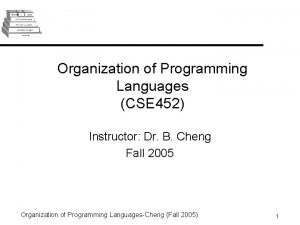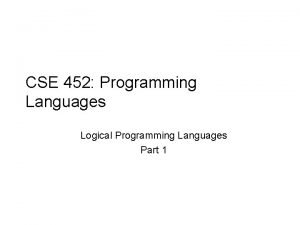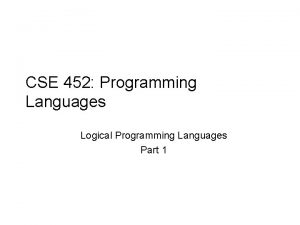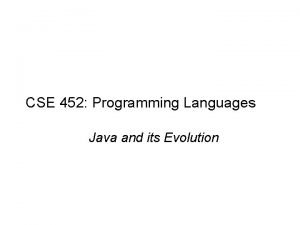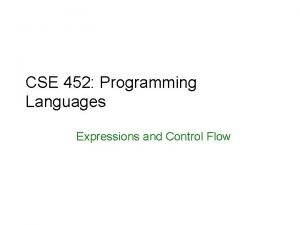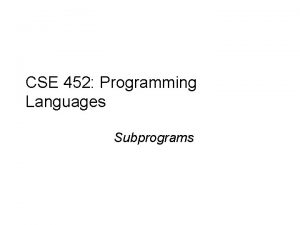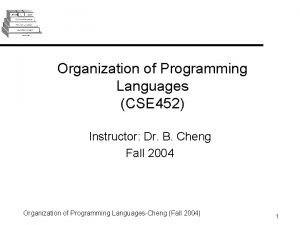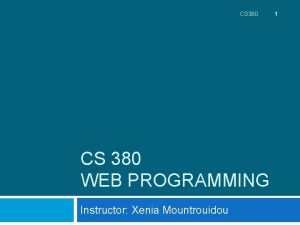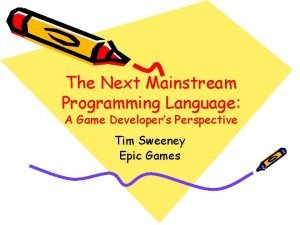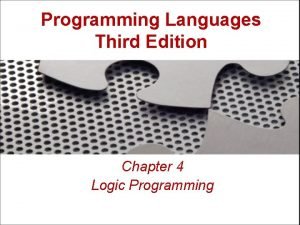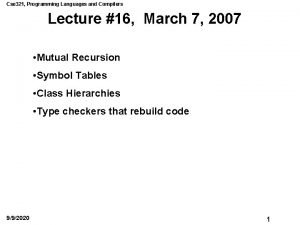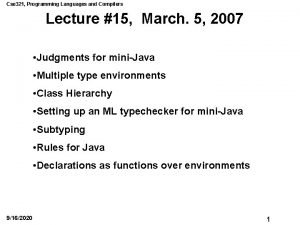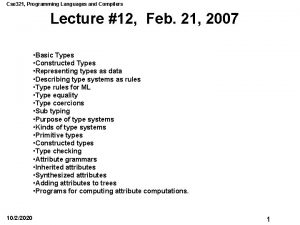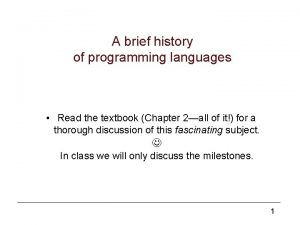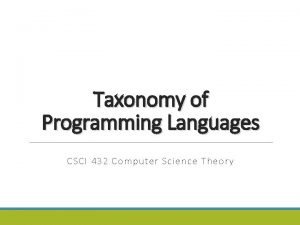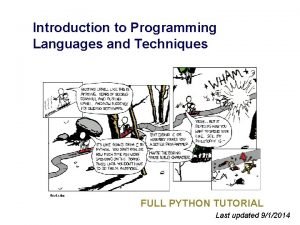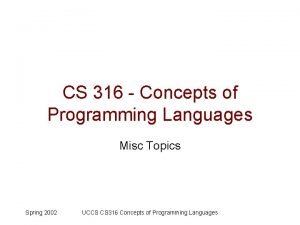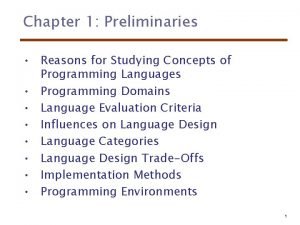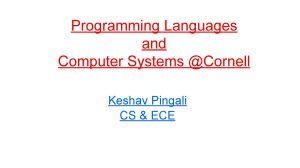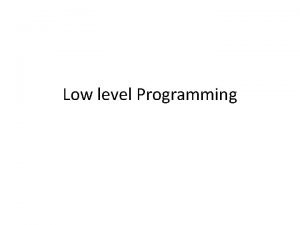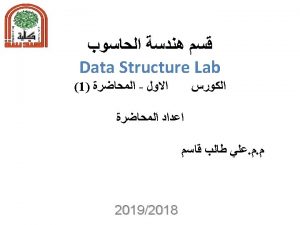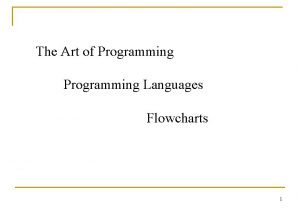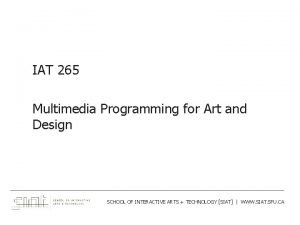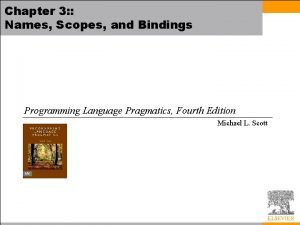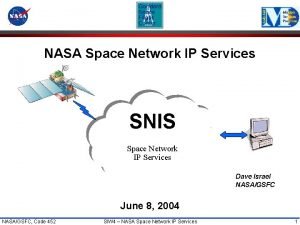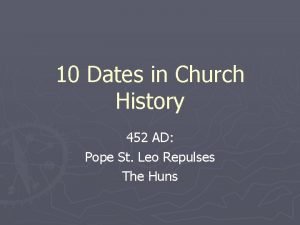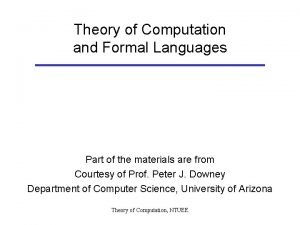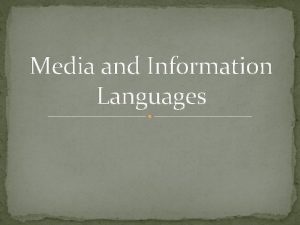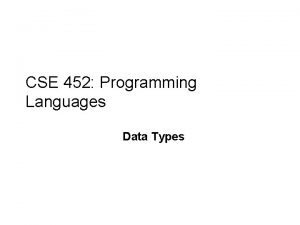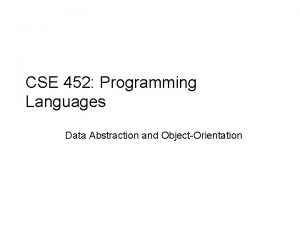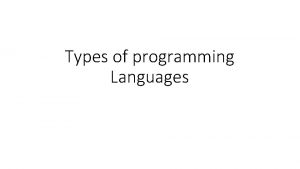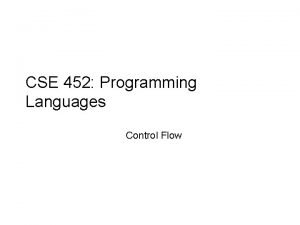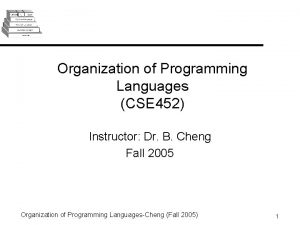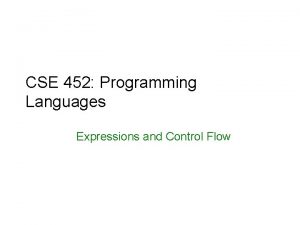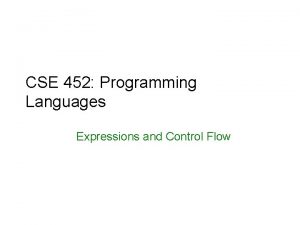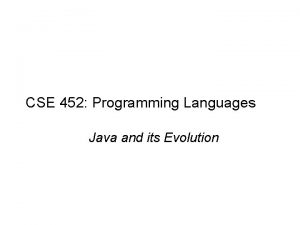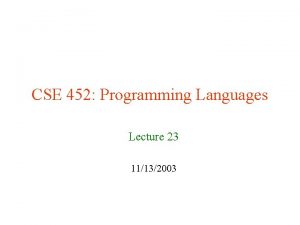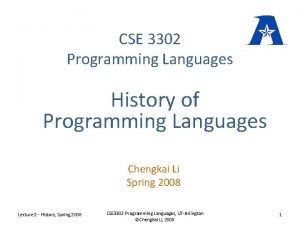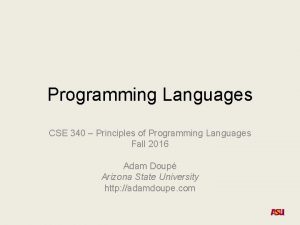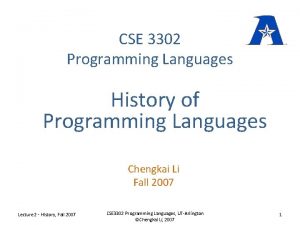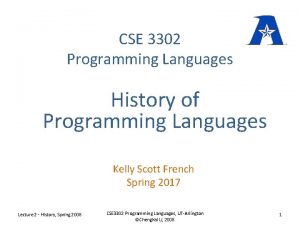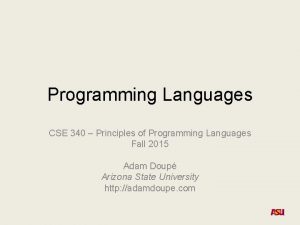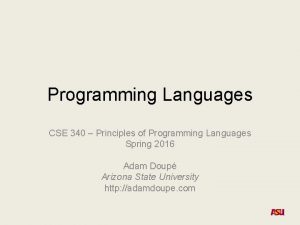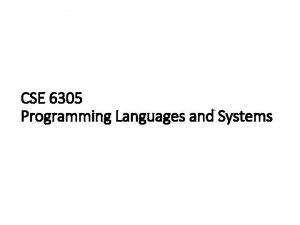CSE 452 Programming Languages Data Types Where are
























































- Slides: 56

CSE 452: Programming Languages Data Types

Where are we? Machine Language Logic You are here High-level Programming Languages Object Oriented Imperative Concepts • specification (syntax, semantics) • variables (binding, scoping, types, …) Assembly Language Functional Implementation • compilation (lexical & syntax analysis) • statements (control, selection, assignment, …) Organization of Programming Languages-Cheng (Fall 2004) 2

Types: Intuitive Perspective u u Behind intuition: l Collection of values from a “domain” (denotational perspective) l Internal structure of data, described down to small set of fundamental types (structural view) l Equivalence class of objects (implementor’s approach) l Collection of well-defined operations that can be applied to objects of that type (abstraction approach Utility of types: l Implicit context l Checking: ensure that certain meaningless operations do not occur. (type checking can’t catch all). Organization of Programming Languages-Cheng (Fall 2004) 3

Terminology u Strong typing: language prevents you from applying an operation to data on which it is not appropriate. u Static typing: compiler can do all the checking at compile time. u Examples: l Common Lisp is strongly typed, but not statically typed. l Ada is statically typed. l Pascal is almost statically typed. l Java is strongly typed, with a non-trivial mix of things that can be checked statically and things that have to be checked dynamically. Organization of Programming Languages-Cheng (Fall 2004) 4

Type System Has rules for : u Type equivalence l (when are the types of two values the same? ) u Type compatibility l (when can a value of type A be used in a context that expects type B? ) u Type inference l (what is the type of an expression, given the types of the operands? ) Organization of Programming Languages-Cheng (Fall 2004) 5

Type compatability/equivalence u Compatability: tells you what you can do l More useful concept of the two l Erroneously used interchangeably u Equivalence: l What are important differences between type declarations? l Format does not matter: struct { int a, b; } u Same as struct { int a, b; } AND struct{ int a; int ; } Organization of Programming Languages-Cheng (Fall 2004) 6

Equivalence: two approaches u Two types: name and structural equivalence u Name Equivalence: based on declarations l More commonly used in current practice l Strict name equivalence: u l Types are equivalent if refer to same declaration Loose name equivalence: u Types are equivalent if they refer to same outermost constructor l u (refer to same declaration after factoring out any type aliases) Structural Equivalence: based on meaning/semantics behind the declarations. l Simple comparison of type descritpions l Substitute out all names; l Expand all the way to built-in types Organization of Programming Languages-Cheng (Fall 2004) 7

Data Types u A data type defines l a collection of data objects, and l a set of predefined operations on the objects type: integer operations: +, -, *, /, %, ^ u Evolution of Data Types l Early days: all programming problems had to be modeled using only a few data types u FORTRAN I (1957) provides INTEGER, REAL, arrays u l Current practice: u Users can define abstract data types (representation + operations) Organization of Programming Languages-Cheng (Fall 2004) 8

Data Types u Primitive Types u Strings u Records u Unions u Arrays u Associative Arrays u Sets u Pointers Organization of Programming Languages-Cheng (Fall 2004) 9

Primitive Data Types u Those not defined in terms of other data types l Numeric types u Integer u Floating point u decimal l Boolean types l Character types Organization of Programming Languages-Cheng (Fall 2004) 10

Numeric Types u Integer l There may be as many as eight different integer types in a language (can you name them? ) l Negative u How numbers to implement them in hardware? Organization of Programming Languages-Cheng (Fall 2004) 11

Representing Negative Integers 1 + (-1) = ? Ones complement, 8 bits u +1 is 0000 0001 u -1 is 1111 1110 u If we use natural method of summation we get sum 1111 + Twos complement, 8 bits u +1 is 0000 0001 u -1 is 1111 u If we use the natural method we get sum 0000 (and carry 1 which we disregard) Organization of Programming Languages-Cheng (Fall 2004) 12

Floating Point u Floating Point l Approximate real numbers Note: even 0. 1 cannot be represented exactly by a finite number of of binary digits! u Loss of accuracy when performing arithmetic operation u l Languages for scientific use support at least two floatingpoint types; sometimes more 1. 63245 x 105 l l l Precision: accuracy of the fractional part Range: combination of range of fraction & exponent Most machines use IEEE Floating Point Standard 754 format Organization of Programming Languages-Cheng (Fall 2004) 13

Floating Point Puzzle True or False? • x == (int)(float) x True • x == (int)(double) x True int x = 1; • f == (float)(double) f True float f = 0. 1; • d == (float) d False double d = 0. 1; • f == -(-f); True • d > f False • -f > -d False • f > d True • -d > -f True • d == f False • (d+f)-d == f True Organization of Programming Languages-Cheng (Fall 2004) 14

Floating Point Representation u. Numerical l – 1 s Form M 2 E u. Sign bit s determines whether number is negative or positive u. Significand M normally a fractional value in range [1. 0, 2. 0). u. Exponent E weights value by power of two u. Encoding s exp frac l MSB is sign bit l exp field encodes E l frac field encodes M Organization of Programming Languages-Cheng (Fall 2004) 15

Floating Point Representation u. Encoding s exp frac MSB is sign bit l exp field encodes E l frac field encodes M l u. Sizes l Single precision: 8 exp bits, 23 frac bits u 32 l Double precision: 11 exp bits, 52 frac bits u 64 l bits total Extended precision: 15 exp bits, 63 frac bits u Only found in Intel-compatible machines u Stored in 80 bits l 1 bit wasted Organization of Programming Languages-Cheng (Fall 2004) 16

Decimal Types u u For business applications ($$$) – e. g. , COBOL Store a fixed number of decimal digits, with the decimal point at a fixed position in the value Advantage l can precisely store decimal values Disadvantages l Range of values is restricted because no exponents are allowed l Representation in memory is wasteful u Representation is called binary coded decimal (BCD) Organization of Programming Languages-Cheng (Fall 2004) 17

Boolean Types u Could be implemented as bits, but often as bytes u Introduced in ALGOL 60 u Included in most general-purpose languages designed since 1960 u Ansi C (1989) l all operands with nonzero values are considered true, and zero is considered false u Advantage: readability Organization of Programming Languages-Cheng (Fall 2004) 18

Character Types u u Characters are stored in computers as numeric codings Traditionally use 8 -bit code ASCII, which uses 0 to 127 to code 128 different characters ISO 8859 -1 also use 8 -bit character code, but allows 256 different characters l Used by Ada 16 -bit character set named Unicode l Includes Cyrillic alphabet used in Serbia, and Thai digits l First 128 characters are identical to ASCII l used by Java and C# Organization of Programming Languages-Cheng (Fall 2004) 19

Character String Types u u Values consist of sequences of characters Design issues: l Is it a primitive type or just a special kind of character array? l Is the length of objects static or dynamic? Operations: l Assignment l Comparison (=, >, etc. ) l Catenation l Substring reference l Pattern matching Examples: l Pascal u l Not primitive; assignment and comparison only Fortran 90 u Somewhat primitive; operations include assignment, comparison, catenation, substring reference, and pattern matching Organization of Programming Languages-Cheng (Fall 2004) 20

Character Strings u Examples l Ada N : = N 1 & N 2 (catenation) N(2. . 4) (substring reference) l C and C++ u l SNOBOL 4 (a string manipulation language) u l Primitive; many operations, including elaborate pattern matching Perl and Java. Script u l Not primitive; use char arrays and a library of functions that provide operations Patterns are defined in terms of regular expressions; a very powerful facility Java String class (not arrays of char); Objects are immutable u String. Buffer is a class for changeable string objects u Organization of Programming Languages-Cheng (Fall 2004) 21

Character Strings u String Length l Static – FORTRAN 77, Ada, COBOL u l e. g. (FORTRAN 90) CHARACTER (LEN = 15) NAME; Limited Dynamic Length – C and C++ u actual length is indicated by a null character Dynamic – SNOBOL 4, Perl, Java. Script Evaluation (of character string types) l Aid to writability l As a primitive type with static length, they are inexpensive to provide l Dynamic length is nice, but is it worth the expense? Implementation l u u Organization of Programming Languages-Cheng (Fall 2004) 22

Ordinal Data Types u Range of possible values can be easily associated with the set of positive integers u Enumeration types l user enumerates all the possible values, which are symbolic constants enum days {Mon, Tue, Wed, Thu, Fri, Sat, Sun}; l Design Issue: Should a symbolic constant be allowed to be in more than one type definition? u Type checking l Are enumerated types coerced to integer? l Are any other types coerced to an enumerated type? u Organization of Programming Languages-Cheng (Fall 2004) 23

Enumeration Data Types u Examples l Pascal u l Ada u l constants can be reused (overloaded literals); disambiguate with context or type_name’(one of them) (e. g, Integer’Last) C and C++ u l cannot reuse constants; can be used for array subscripts, for variables, case selectors; can be compared enumeration values are coerced into integers when put in integer context Java u u does not include an enumeration type, but provides the Enumeration interface can implement them as classes class colors { public final int red = 0; public final int blue = 1; } Organization of Programming Languages-Cheng (Fall 2004) 24

Subrange Data Types u An ordered contiguous subsequence of an ordinal type l e. g. , 12. . 14 is a subrange of integer type l Design Issue: How can they be used? l Examples: u Pascal l l u Ada l u subrange types behave as their parent types; can be used as for variables and array indices type pos = 0. . MAXINT; Subtypes are not new types, just constrained existing types (so they are compatible); can be used as in Pascal, plus case constants subtype POS_TYPE is INTEGER range 0. . INTEGER'LAST; Evaluation u Aid to readability - restricted ranges add error detection Organization of Programming Languages-Cheng (Fall 2004) 25

Implementation of Ordinal Types u Enumeration types are implemented as integers u Subrange types are the parent types with code inserted (by the compiler) to restrict assignments to subrange variables Organization of Programming Languages-Cheng (Fall 2004) 26

Arrays u An aggregate of homogeneous data elements in which an individual element is identified by its position in the aggregate, relative to the first element u Design Issues: l What types are legal for subscripts? l Are subscripting expressions in element references range checked? l When are subscript ranges bound? l When does allocation take place? l What is the maximum number of subscripts? l Can array objects be initialized? l Are any kind of slices allowed? Organization of Programming Languages-Cheng (Fall 2004) 27

Arrays u Indexing is a mapping from indices to elements l map(array_name, index_value_list) an element u Index Syntax l FORTRAN, PL/I, Ada use parentheses: l most other languages use brackets: u A(3) A[3] Subscript Types: l FORTRAN, C - integer only l Pascal - any ordinal type (integer, boolean, char, enum) l Ada - integer or enum (includes boolean and char) l Java - integer types only Organization of Programming Languages-Cheng (Fall 2004) 28

Arrays u Five Categories of Arrays (based on subscript binding and binding to storage) l Static l Fixed stack dynamic l Stack dynamic l Fixed Heap dynamic l Heap dynamic Organization of Programming Languages-Cheng (Fall 2004) 29

Arrays u Static l range of subscripts and storage bindings are static l e. g. FORTRAN 77, some arrays in Ada l Arrays declared in C and C++ functions that include the static modifier are static l Advantage: execution efficiency (no allocation or deallocation) u Fixed stack dynamic l range of subscripts is statically bound, but storage is bound at elaboration time u l l Elaboration time: when execution reaches the code to which the declaration is attached Most Java locals, and C locals that are not static Advantage: space efficiency Organization of Programming Languages-Cheng (Fall 2004) 30

Arrays u Stack-dynamic l range and storage are dynamic, but fixed from then on for the variable’s lifetime e. g. Ada declare blocks declare STUFF : array (1. . N) of FLOAT; begin. . . end; l Advantage: flexibility - size need not be known until array is about to be used Organization of Programming Languages-Cheng (Fall 2004) 31

Arrays u Fixed Heap dynamic l Binding of subscript ranges and storage are dynamic, but are both fixed after storage is allocated l Binding done when user program requests them, rather than at elaboration time and storage is allocated on the heap, rather than the stack l In Java, all arrays are objects (heap-dynamic) l C# also provides fixed heap-dynamic arrays Organization of Programming Languages-Cheng (Fall 2004) 32

Arrays u Heap-dynamic l subscript range and storage bindings are dynamic and not fixed l e. g. (FORTRAN 90) INTEGER, ALLOCATABLE, ARRAY (: , : ) : : MAT (Declares MAT to be a dynamic 2 -dim array) ALLOCATE (MAT (10, NUMBER_OF_COLS)) (Allocates MAT to have 10 rows and NUMBER_OF_COLS columns) DEALLOCATE MAT (Deallocates MAT’s storage) l Perl and Java. Script support heap-dynamic arrays u u arrays grow whenever assignments are made to elements beyond the last current element Arrays are shrunk by assigning them to empty array Perl: @my. Array = ( ); Organization of Programming Languages-Cheng (Fall 2004) 33

Arrays u u Number of subscripts (dimensions) l FORTRAN I allowed up to three l FORTRAN 77 allows up to seven l Others - no limit Array Initialization l Usually just a list of values that are put in the array in the order in which the array elements are stored in memory l Examples: u FORTRAN - uses the DATA statement Integer List(3) Data List /0, 5, 5/ u C and C++ - put the values in braces; let compiler count them int stuff [] = {2, 4, 6, 8}; u Ada - positions for the values can be specified SCORE : array (1. . 14, 1. . 2) : = (1 => (24, 10), 2 => (10, 7), 3 =>(12, 30), others => (0, 0)); u Pascal does not allow array initialization Organization of Programming Languages-Cheng (Fall 2004) 34

Arrays: Operations u u Ada l Assignment; RHS can be an aggregate constant or an array name l Catenation between single-dimensioned arrays FORTRAN 95 l Includes a number of array operations called elementals because they are operations between pairs of array elements u u E. g. , add (+) operator between two arrays results in an array of the sums of element pairs of the two arrays Slices l A slice is some substructure of an array l FORTRAN 90 INTEGER MAT (1 : 4, 1 : 4) MAT(1 : 4, 1) - the first column MAT(2, 1 : 4) - the second row l Ada - single-dimensioned arrays only LIST(4. . 10) Organization of Programming Languages-Cheng (Fall 2004) 35

Arrays u Implementation of Arrays l Access function maps subscript expressions to an address in the array l Single-dimensioned array address(list[k]) = address(list[lower_bound]) + (k-1)*element_size = (address[lower_bound] – element_size) + (k * element_size) 3 4 7 l Multi-dimensional arrays Row major order: u Column major order u 3, 4, 7, 6, 2, 5, 1, 3, 8 3, 6, 1, 4, 2, 3, 7, 5, 8 Organization of Programming Languages-Cheng (Fall 2004) 6 2 5 7 1 3 8 36

Associative Arrays u An unordered collection of data elements that are indexed by an equal number of values called keys l also known as hashes u Design Issues: l What is the form of references to elements? l Is the size static or dynamic? Organization of Programming Languages-Cheng (Fall 2004) 37

Associative Arrays u Structure and Operations in Perl l Names begin with % l Literals are delimited by parentheses l %hi_temps = ("Monday" => 77, "Tuesday" => 79, …); l Subscripting is done using braces and keys l e. g. , $hi_temps{"Wednesday"} = 83; u Elements can be removed with delete l e. g. , delete $hi_temps{"Tuesday"}; Organization of Programming Languages-Cheng (Fall 2004) 38

Records u. A (possibly heterogeneous) aggregate of data elements in which the individual elements are identified by names u Design Issues: l What is the form of references? l What unit operations are defined? Organization of Programming Languages-Cheng (Fall 2004) 39

Records u Record Definition Syntax l COBOL uses level numbers to show nested records; others use recursive definitions l COBOL 01 EMPLOYEE-RECORD. 02 EMPLOYEE-NAME. 05 FIRST 05 MIDDLE 05 LAST 02 HOURLY-RATE PICTURE IS X(20). PICTURE IS X(10). PICTURE IS X(20). PICTURE IS 99 V 99. Level numbers (01, 02, 05) indicate their relative values in the hierarchical structure of the record PICTURE clause show the formats of the field storage locations X(20): 20 alphanumeric characters 99 V 99: four decimal digits with decimal point in the middle Organization of Programming Languages-Cheng (Fall 2004) 40

Records u Ada: Type Employee_Name_Type is record First: String (1. . 20); Middle: String (1. . 10); Last: String (1. . 20); end record; type Employee_Record_Type is record Employee_Name: Employee_Name_Type; Hourly_Rate: Float; end record; Employee_Record: Employee_Record_Type; Organization of Programming Languages-Cheng (Fall 2004) 41

Records u References to Record Fields u COBOL field references field_name OF record_name_1 OF … OF record_name_n e. g. MIDDLE OF EMPLOYEE-NAME OF EMPLOYEE_RECORD u Fully qualified references must include all intermediate record names u Elliptical references allow leaving out record names as long as the reference is unambiguous - e. g. , the following are equivalent: FIRST, FIRST OF EMPLOYEE-NAME, FIRST OF EMPLOYEE-RECORD Organization of Programming Languages-Cheng (Fall 2004) 42

Records u Operations l Assignment u Pascal, l Ada, and C allow it if the types are identical In Ada, the RHS can be an aggregate constant l Initialization u Allowed in Ada, using an aggregate constant l Comparison u In Ada, = and /=; one operand can be an aggregate constant l MOVE CORRESPONDING u In COBOL - it moves all fields in the source record to fields with the same names in the destination record Organization of Programming Languages-Cheng (Fall 2004) 43

Comparing Records to Arrays u Access to array elements is much slower than access to record fields, because subscripts are dynamic (field names are static) u Dynamic subscripts could be used with record field access, but it would disallow type checking and it would be much slower Organization of Programming Languages-Cheng (Fall 2004) 44

Unions u u u A type whose variables are allowed to store different type values at different times during execution Design Issues for unions: l What kind of type checking, if any, must be done? l Should unions be integrated with records? Examples: l FORTRAN - with EQUIVALENCE u l No type checking Pascal u both discriminated and nondiscriminated unions type intreal = record tagg : Boolean of true : (blint : integer); false : (blreal : real); end; u Problem with Pascal’s design: type checking Organization of Programming Languages-Cheng (Fall 2004) is ineffective 45

Unions u Example (Pascal)… l Reasons why Pascal’s unions cannot be type checked effectively: u User can create inconsistent unions (because the tag can be individually assigned) var blurb : intreal; x : real; blurb. tagg : = true; blurb. blint : = 47; blurb. tagg : = false; x : = blurb. blreal; real } { { it is an integer } ok } it is a real } assigns an integer to a The tag is optional! u Now, only the declaration and the second and last assignments are required to cause trouble u Organization of Programming Languages-Cheng (Fall 2004) 46

Unions u Examples… l Ada discriminated unions u Reasons they are safer than Pascal: u l l l Tag must be present It is impossible for the user to create an inconsistent union (because tag cannot be assigned by itself -- All assignments to the union must include the tag value, because they are aggregate values) C and C++ free unions (no tags) u Not part of their records u l l u No type checking of references Java has neither records nor unions Evaluation - potentially unsafe in most languages (not Ada) Organization of Programming Languages-Cheng (Fall 2004) 47

Sets u u u A type whose variables can store unordered collections of distinct values from some ordinal type Design Issue: l What is the maximum number of elements in any set base type? Example l Pascal No maximum size in the language definition (not portable, poor writability if max is too small) u Operations: in, union (+), intersection (*), difference (-), =, <>, superset (>=), subset (<=) u l Ada u l does not include sets, but defines in as set membership operator for all enumeration types Java u includes a class Languages-Cheng for set operations Organization of Programming (Fall 2004) 48

Sets u Evaluation l If a language does not have sets, they must be simulated, either with enumerated types or with arrays l Arrays are more flexible than sets, but have much slower set operations u Implementation l Usually stored as bit strings and use logical operations for the set operations Organization of Programming Languages-Cheng (Fall 2004) 49

Pointers u u A pointer type is a type in which the range of values consists of memory addresses and a special value, nil (or null) Uses: l Addressing flexibility l Dynamic storage management Design Issues: l What is the scope and lifetime of pointer variables? l What is the lifetime of heap-dynamic variables? l Are pointers restricted to pointing at a particular type? l Are pointers used for dynamic storage management, indirect addressing, or both? l Should a language support pointer types, reference types, or both? Fundamental Pointer Operations: l Assignment of an address to a pointer l References (explicit versus implicit dereferencing) Organization of Programming Languages-Cheng (Fall 2004) 50

Pointers u Problems with pointers: l Dangling pointers (dangerous) A pointer points to a heap-dynamic variable that has been deallocated u Creating one (with explicit deallocation): u l l Allocate a heap-dynamic variable and set a pointer to point at it Set a second pointer to the value of the first pointer Deallocate the heap-dynamic variable, using the first pointer Lost Heap-Dynamic Variables ( wasteful) A heap-dynamic variable that is no longer referenced by any program pointer u Creating one: u l l u Pointer p 1 is set to point to a newly created heap-dynamic variable p 1 is later set to point to another newly created heap-dynamic variable The process of losing heap-dynamic variables is called memory leakage Organization of Programming Languages-Cheng (Fall 2004) 51

Pointers u Examples: l Pascal used for dynamic storage management only u Explicit dereferencing (postfix ^) u Dangling pointers are possible (dispose) u Dangling objects are also possible u l Ada a little better than Pascal u Some dangling pointers are disallowed because dynamic objects can be automatically deallocated at the end of pointer's type scope u All pointers are initialized to null u Similar dangling object problem (but rarely happens, because explicit deallocation is rarely done) u Organization of Programming Languages-Cheng (Fall 2004) 52

Pointers u Examples… l C and C++ Used for dynamic storage management and addressing u Explicit dereferencing and address-of operator u Can do address arithmetic in restricted forms u Domain type need not be fixed (void * ) float stuff[100]; float *p; p = stuff; u *(p+5) is equivalent to stuff[5] and p[5] *(p+i) is equivalent to stuff[i] and p[i] (Implicit scaling) void * - Can point to any type and can be type checked (cannot be dereferenced) Organization of Programming Languages-Cheng (Fall 2004) 53

Pointers u Examples… l FORTRAN 90 Pointers Can point to heap and non-heap variables u Implicit dereferencing u Pointers can only point to variables that have the TARGET attribute u The TARGET attribute is assigned in the declaration, as in: INTEGER, TARGET : : NODE u A special assignment operator is used for non-dereferenced references REAL, POINTER : : ptr (POINTER is an attribute) ptr => target (where target is either a pointer or a nonpointer with the TARGET attribute)) This sets ptr to have the same value as target u Organization of Programming Languages-Cheng (Fall 2004) 54

Pointers u Examples… l C++ Reference Types Constant pointers that are implicitly dereferenced u Used for parameters u Advantages of both pass-by-reference and pass-by-value u l Java Only references u No pointer arithmetic u Can only point at objects (which are all on the heap) u No explicit deallocator (garbage collection is used) u Means there can be no dangling references u Dereferencing is always implicit u Organization of Programming Languages-Cheng (Fall 2004) 55

Pointers u Evaluation l Dangling pointers and dangling objects are problems, as is heap management l Pointers are like goto's--they widen the range of cells that can be accessed by a variable l Pointers or references are necessary for dynamic data structures--so we can't design a language without them Organization of Programming Languages-Cheng (Fall 2004) 56
 Antigentest åre
Antigentest åre Adam doupe cse 340
Adam doupe cse 340 Cse 340 principles of programming languages
Cse 340 principles of programming languages Cse 452
Cse 452 Cse452
Cse452 Cse 452
Cse 452 Cse 452
Cse 452 Cse452
Cse452 Cse 452
Cse 452 Cse 452
Cse 452 Cse 452
Cse 452 Strongly typed vs weakly typed
Strongly typed vs weakly typed Int vs short
Int vs short Real-time systems and programming languages
Real-time systems and programming languages Elsa gunter uiuc
Elsa gunter uiuc Thread dalam java
Thread dalam java Programming languages levels
Programming languages levels Introduction to programming languages
Introduction to programming languages Plc
Plc Procedural programming languages
Procedural programming languages Comparative programming languages
Comparative programming languages Alternative programming languages
Alternative programming languages Transmission programming languages
Transmission programming languages Xenia programming languages
Xenia programming languages Advantages of high level language
Advantages of high level language Mainstream programming languages
Mainstream programming languages Programing languages
Programing languages Programming languages
Programming languages Programming languages
Programming languages Programming languages
Programming languages Tiny programming language
Tiny programming language Brief history of programming languages
Brief history of programming languages Lisp_q
Lisp_q Real time programming language
Real time programming language Xkcd programming
Xkcd programming If programming languages were cars
If programming languages were cars Reasons for studying concepts of programming languages
Reasons for studying concepts of programming languages Cornell programming languages
Cornell programming languages Low level programming languages
Low level programming languages Middle level programming languages
Middle level programming languages The art of programming
The art of programming Cs 421 uiuc
Cs 421 uiuc Iat 265
Iat 265 Storage management in programming languages
Storage management in programming languages Find the number of moles of argon in 452 g of argon
Find the number of moles of argon in 452 g of argon Ip de la nasa
Ip de la nasa En yakın yüzlük
En yakın yüzlük 452 ad
452 ad Sandrit 452
Sandrit 452 Perbedaan linear programming dan integer programming
Perbedaan linear programming dan integer programming Greedy vs dynamic
Greedy vs dynamic Runtime programming
Runtime programming Integer programming vs linear programming
Integer programming vs linear programming Perbedaan linear programming dan integer programming
Perbedaan linear programming dan integer programming Types of languages in theory of computation
Types of languages in theory of computation Types of media languages
Types of media languages Types of languages
Types of languages



